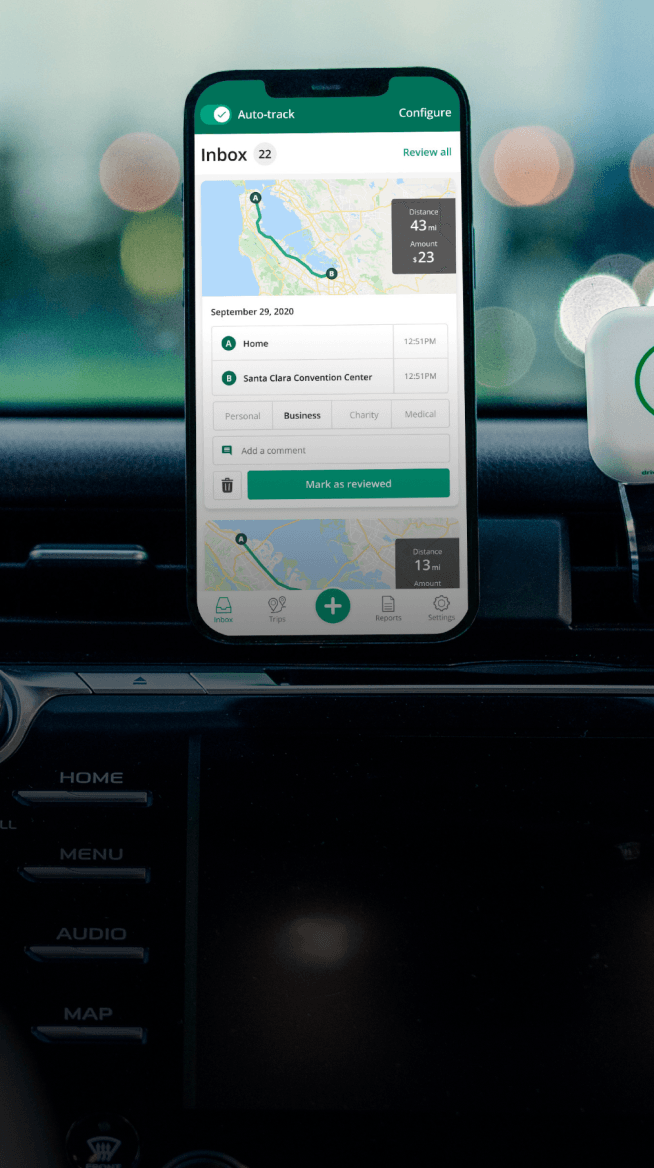Track mileage automatically
Get started.svg)
How To Claim Car Depreciation from the IRS
If you're a small business owner, unlocking every deduction you are entitled to can improve your business and bottom line.
One of the most significant deductions many small business owners are unaware of is car depreciation. So, if you're using your car for business, you can deduct the depreciation on your taxes. Depreciation is the continual decline in the value of a property with a useful life of more than one year.
How to claim vehicle depreciation
There are two ways to calculate and deduct car depreciation: the standard mileage rate and the actual expense method.
Car depreciation is part of the standard mileage rate
You don't need to calculate depreciation separately using the standard mileage rate, as the IRS considers depreciation when setting this rate.
In this case, you only need to keep track of the miles you drive for business purposes –mainly if you use the car for business and personal purposes. In that case, you can only claim deductions for your business miles.
An easy way to track this is using an app like Driversnote. The app tracks your miles and makes it easy to classify a trip as business or personal. See the IRS rules on recording mileage and claiming mileage deductions in our IRS mileage guide.
Using the actual expenses to deduct depreciation
If you use the actual expenses method instead of a standard rate, you track all expenses you incur when operating your vehicle for business use.
These expenses include repairs, oil, registration, gas, insurance, tires, license fees, and depreciation or lease payments.
Switching between standard mileage rates and actual expenses
If you use the standard mileage method in the first year, you can switch to the actual expenses method the following year.
But if you use the actual expenses method the first year, you can't change to another method in future years. Regardless of your method, keep careful records if you get audited.


Mileage tracking made easy
Trusted by millions of drivers
Automate your logbook Automate your logbook

Automatic mileage tracking and IRS-compliant reporting.
Get started for free Get started for freeHow to calculate car depreciation for tax claims
As depreciation is already included in the standard mileage deduction, we'll focus on the actual expenses method. In this method, you can claim your vehicle depreciation as part of your expenses. This is allowed even if you financed your vehicle.
Using your car for business more than 50% of the time?
First, you need to know if you use your car for business more than 50% of the time. In that case, and when your car is placed in service after 1986, you're required to use the Modified Accelerated Cost Recovery System (MACRS) where you'll need to answer:
-
The basis of your vehicle, i.e., the amount you paid for the vehicle plus any fees, the cost of registration, and taxes.
-
The date you placed the car in service.
-
The percentage for which you use the car for business. Then, multiply the basis by the percentage of the vehicle used for business.
You can use IRS Form 4562 to calculate your depreciation when you have this information.
If you use your car for business less than 50% of the time
If the vehicle is used for business less than 50% of the time, you must use the straight-line depreciation method.
How do you calculate straight-line depreciation?
To calculate straight-line depreciation, you start by finding the net price of the asset.
This is done by subtracting the salvage value (the expected value at the end of its useful life) from the purchase price. Then, divide the net price by the years you expect to use the asset.
This method spreads the asset's cost evenly over its useful life, making it easier to see how it affects your financial statements each year.
Another scenario in which you would use the straight-line depreciation method is if you initially used the standard mileage rate in the first year of vehicle ownership but later switched to the actual expenses method.
In this case, straight-line depreciation must be used for the remainder of the vehicle's useful life.
Example: Calculating car depreciation
This might all seem a bit abstract, so here's a specific example:
You started using your car for business on January 1, 2022. The car costs you $30,000, and you use it for business 60% of the time.
This means the part of the car's cost you can depreciate is:
$30,000 × 60% = $18,000.
According to the Modified Accelerated Cost Recovery System (MACRS), cars are classified as a five-year property for tax purposes, which means the standard depreciation schedule is five years.
Typically, for vehicles, you will use the 200% declining balance method for depreciation.
To find the depreciation rate, divide 200% by 5 years:
200% ÷ 5 = 40%.
Now, apply this rate to your $18,000 business use amount:
$18,000 × 40% = $7,200.
So, in the first year, you can deduct $7,200 as depreciation. You will keep using this method until the straight-line depreciation exceeds the declining balance rate.
To find the straight-line rate, divide 1 by the number of years left in the recovery period at the start of the year. You will switch to this rate once it exceeds the declining balance rate.
FAQ

Tired of logging mileage by hand?
Effortless. IRS-compliant. Liberating.
Top posts
Related posts
IRS Mileage Guide
Latest update: April 24, 2025 - 10 min read
Mileage reimbursement in the US — rates and rules for employees, self-employed and employers in the US.
IRS Mileage
Latest update: December 23, 2024 - 2 min read
Find out what IRS mileage is and how you can claim it. See how much you can claim per mile from the IRS for your business-related driving.
DoorDash Background Check
Latest update: January 29, 2025 - 2 min read
Here’s what to expect when DoorDash conducts background checks, how Checkr works, and why it may take longer to get approved.

